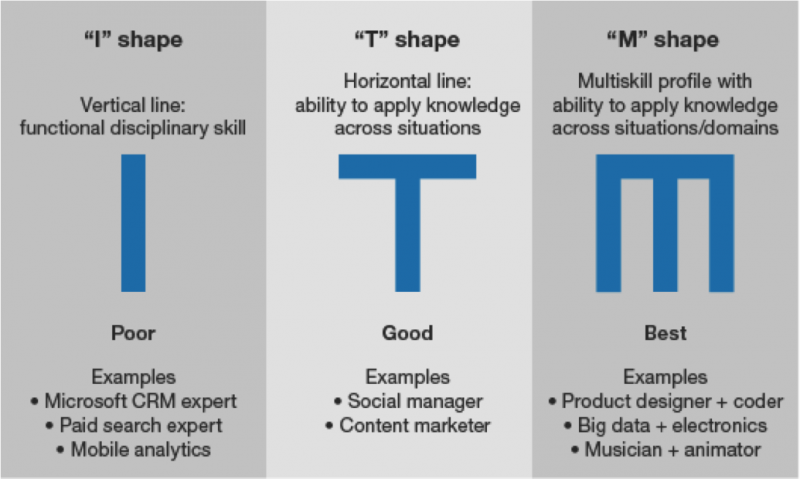Find, Support, And Keep Emerging Touchpoint Talent
Traditional marketing organisation structures are failing touchpoint innovation. With marketing teams largely organised by channels such as search, display, social, and customer care, there is little incentive to think laterally about problems and opportunities across the group.
Emerging touchpoints often redefine and cross channel boundaries, which can quite quickly cause problems for teams with restricted views, budgets, and personnel. Take the emerging touchpoint of interactive video, for example, which turns video content into a microsite and has implications on eCommerce, search engine tactics, social, and content marketing. Aside from process and budgeting issues, many brands find that staff members who have worked together for years find it difficult to break out of their habits when asked to embrace and drive the 'new'.
So what does this emerging touchpoint talent look like? Along with core qualities of entrepreneurial drive, creativity, and the ability to work flexibly across direct and virtual teams, there is also a skills profile that suits this multifarious role. Emerging touchpoint staff members have a wholly different profile from staff members in your ROI-driven, core marketing machine, who typically have a single specialism. In 1991, Tim Brown, the CEO of Ideo, described this flexibility as a T-shaped skill set. While he intended it to be used for collaboration across roles, it's also a useful way to think about a broadening of functional skills, resembling more of an "M" shape. See the figure below for an illustration of this new balance with greater emphasis on multiple skills.

Where are they to be found?
The emerging role is too important to outsource, as this type of hire is an investment in reshaping your organization's culture to adapt to a digitally disruptive business climate — a future norm. Finding these staff members is not easy so do the following :
• Avoid Traditional recruitment agencies which don't support this kind of hire. While recruitment agencies may be able to source Microsoft Dynamics gurus and other vertical specialists, our interviewees tell us they are mostly unable to deliver talent for emerging roles. The agency Ogilvy & Mather cites a lack of geographic coverage and lateral thinking — for example, when tasked with finding social talent, recruiters typically default to simply trying to get someone to switch from an existing social agency. With roughly only one CV in 10 of any use, recruitment agencies do not represent an effective emerging role hire path.
• Support self-selection to discover internal candidates. Finding the most innovative people in your firm becomes more difficult the larger your organisation is, and many staff members who would do well may be in positions that aren’t necessarily deemed innovative. Existing marketing leaders often obtain their positions through diligence in profitability and cost and can therefore struggle with the uncertainty and less-defined ROI models of emerging methods — causing them to reduce scope to something more comfortable. HR teams typically aren’t qualified or sufficiently staffed to develop managers to spot for this type of talent or to undertake the search themselves, so democratising opportunities for virtual teams and other initiatives provides a path for candidates to step forward.
• Leverage the social graph of your employees. People who work in your environment already understand the company culture and what is required of employees. Incentivizing your people to leverage their business and social graphs is an effective way to cast the net. The reach quite quickly becomes apparent — with an average of 150 social contacts per employee, a company of 100 would have 15,000 primary and 2.25 million second-degree contacts. This also produces a hire that is more likely to stick. A Jobvite survey in 2013 on social recruiting showed that candidates sourced through referrals versus general hires are 4.4x more successful in getting the job and 3x more likely to stay longer than three years.
Demand for emerging touchpoint staff is high, but there is also the challenge of hanging onto them once hired. So how do you go about supporting and keeping them?
• Support touchpoint talent with fearless and flexible management. This shift in the skills landscape is a challenge for managers who must deal with digitally native staff members who are often younger and who not only work and think differently but may well have digital capabilities that have overtaken those of their managers. Managers: You must get over this. To support the growth of these staff members, managers must use different techniques than they use for their ROI-centric core marketing practices. They must create an environment where playful experimentation is rewarded, staff members are trusted to develop their own processes, and appropriate business measures are used at the right stage of innovation.
• Keep touchpoint talent by providing a variety of short- to mid-term challenges. A small pool of digital talent makes for a highly competitive hiring environment and places power in the hands of potential hires. Management must keep up with them and regularly challenge them inside a company culture that too often can be slow moving. Hang onto these precious resources by ensuring that their work receives recognition, appropriate reward schemes are in place, and they are not turned into operational staff for the touchpoints that they create.
My new report on how to Find, Support and Keep Emerging Touchpoint Talent is out now and looks further into where these exotic and critical staff members are to be found, how managers should support them, and how to hang onto them once you have them in your organisation.
I'd love to hear from you too – any horror stories? tips? questions?